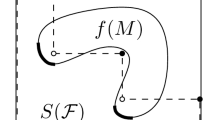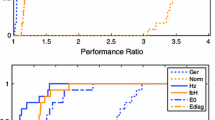Abstract
A general class of branch and bound algorithms forsolving a wide class of nonlinear programs with branching only in asubset of the problem variables is presented. By reducing the dimension of thesearch space, this technique may dramatically reduce the number ofiterations and time required for convergence to ∈ tolerancewhile retaining proven exact convergence in the infinite limit. Thispresentation includes specifications of the class of nonlinearprograms, a statement of a class of branch and bound algorithms, aconvergence proof, and motivating examples with results.
Similar content being viewed by others
References
F. A. Al-Khayyal and J. E. Falk. Jointly constrained biconvex programming. Mathematics of Operations Research, 8(2):273–286, 1983.
I. P. Androulakis, C. D. Maranas, and C. A. Floudas. α_BB: A global optimization method for general constrainted nonconvex problems. Journal of Global Optimization, 7(4):337–363, 1995.
T. G. W. Epperly and R. E. Swaney. Branch and bound for global NLP: New bounding LP. In Ignacio E. Grossmann (ed.), Global Optimization in Engineering Design, chapter 1. Kluwer, 1996.
J. E. Falk and R. M. Soland. An algorithm for separable nonconvex programming problems. Management Science, 15(9):550–569, 1969.
R. Horst. An algorithm for nonconvex programming. Mathematical Programming, 10:312–21, 1976.
R. Horst. Deterministic global optimization with partition sets whose feasibility is not known: Application to concave minimization, reverse convex constraints, DC-programming, and Lipschitzian optimization. Journal of Optimization Theory and Application, 58(1):11–37, 1988.
R. Horst and N. V. Thoai. Conical algorithm for the global minimization of linearly constrained decomposable concave minimization problems. Journal of Optimization Theory and Applications, 74(3):469–486, 1992.
R. Horst and N. V. Thoai. Constraint decomposition algorithms in global optimization. Journal of Global Optimization, 5:333–348, 1994.
M. G. Ierapetritou and E. N. Pistikopoulos. Batch plant design and operations under uncertainty. Industrial & Engineering Chemistry Research, 35(2):772–787, 1996.
G. P. McCormick. Computability of global solutions to factorable nonconvex programs: Part I — Convex underestimating problems. Mathematical Programming, 10:147–175, 1976.
G. P. McCormick. Nonlinear Programming, Theory, Algorithms, and Applications. John Wiley & Sons, 1983.
B. A. Murtagh and M. A. Saunders. MINOS 5.1 user’s guide. Technical Report SOL 83-20R, Systems Optimization Laboratory, Stanford University, Stanford, CA 94305–4022, 1987.
L. D. Muu. An algorithm for solving convex programs with an additional convex-concave constraint. Mathematical Programming, 61:75–87, 1993.
L. D. Muu and W. Oettli. Combined branch-and-bound and cutting plane methods for solving a class of nonlinear programming problems. Journal of Global Optimization, 3:377–391, 1993.
A. Neumaier. Interval Methods for Systems of Equations. Encyclopedia of Mathematics and Its Applications. Cambridge University Press, 1990.
A. T. Phillips and J. B. Rosen. A parallel algorithm for constrained concave quadratic global minimization. Mathematical Programming, 42:421–448, 1988.
T. Q. Phong, L. T. H. An, and P. D. Tao. Decomposition branch and bound method for globally solving linearly constrained indefinite quadratic minimization problems. Operations Research Letters, 17:215–220, 1995.
I. Quesada and I. E. Grossmann. Aglobal optimization algorithmfor linear fractional and bilinear programs. Journal of Global Optimization, 6:39–76, 1995.
H. S. Ryoo and N. V. Sahinidis. Global optimization of nonconvex NLPs and MINLPs with applications in process design. Computers and Chemical Engineering, 19(5):551–566, 1995.
H. D. Sherali and A. Alameddine. A new reformulation-linearization technique for bilinear programming problems. Journal of Global Optimization, 2:379–410, 1992.
H. D. Sherali and C. H. Tuncbilek. A global optimization algorithm for polynomial programming problems using a reformulation-linearization technique. Journal of Global Optimization, 2:101–112, 1992.
H. D. Sherali and C. H. Tuncbilek. A reformulation-convexification approach for solving nonconvex quadratic programming problems. Journal of Global Optimization, 7:1–31, 1995.
E. M. B. Smith and C. C. Pantelides. Global optimization of general process models. In Ignacio E. Grossmann, editor, Global Optimization in Engineering Design, chapter 12. Kluwer, 1996.
H. Tuy. Effect of the subdivision strategy on convergence and efficiency of some global optimization algorithms. Journal of Global Optimization, 1(1):23–36, 1991.
Author information
Authors and Affiliations
Rights and permissions
About this article
Cite this article
Epperly, T.G.W., Pistikopoulos, E.N. A Reduced Space Branch and Bound Algorithm for Global optimization. Journal of Global Optimization 11, 287–311 (1997). https://doi.org/10.1023/A:1008212418949
Issue Date:
DOI: https://doi.org/10.1023/A:1008212418949




